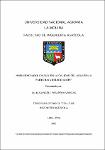Mostrar el registro sencillo del ítem
Influencia del caudal en la calidad del agua en la parte baja del Río Lurín
| dc.contributor.advisor | Ramos Fernández, Lía | |
| dc.contributor.author | Pasapera Vargas, Lilian Angeli | |
| dc.date.accessioned | 2019-09-10T14:10:17Z | |
| dc.date.available | 2019-09-10T14:10:17Z | |
| dc.date.issued | 2019 | |
| dc.identifier.other | P10.P27 - T BAN UNALM | |
| dc.identifier.uri | https://hdl.handle.net/20.500.12996/4099 | |
| dc.description | Universidad Nacional Agraria La Molina. Facultad de Ingeniería Agrícola. Departamento Académico de Recursos Hídricos | es_PE |
| dc.description.abstract | El río Lurín en su tramo bajo presenta problemas de contaminación, por ello el interés de la presente investigación en evaluar la influencia del caudal en la calidad del agua de la parte baja del río Lurín, ya que es determinante en su capacidad de autopurificación. Para ello, ante la ausencia de información hidrológica en ciertos puntos de monitoreo, se simuló en la estación Antapucro los caudales, empleando el programa HEC-HMS, previamente calibrado y validado. Luego, por balance, se estimó los caudales requeridos en las estaciones de monitoreo de calidad del agua. Los parámetros de calidad del agua, se analizaron en función a los estándares de calidad ambiental (ECA) del agua para uso agrícola y recreacional, determinándose, que los indicadores microbiológicos escherichia coli y coliformes termotolerantes (CT), en el tramo de las estaciones L1, puente panamericana sur, a L4, 50 metros antes del vertimiento de la planta de tratamiento de agua residual (PTAR) de San Bartolo, en el período húmedo y seco, no cumplían los ECA del agua ya que lo superaban en más de un 100 por ciento. En las tres últimas estaciones de monitoreo (L10-EF, L11 y L12), se obtuvo una correlación negativa significativa entre el caudal y los parámetros de conductividad eléctrica, demanda bioquímica de oxígeno, potencial de hidrógeno y sólidos totales, interpretándose que a mayor caudal hay una menor concentración de estos. El déficit de oxígeno disuelto llegó a valores máximos de 7,5 mg/l en el periodo seco, específicamente cerca a la desembocadura del río, ya que aguas arriba ingresan los vertimientos de las PTAR Julio C. Tello y San Bartolo, y el agua residual doméstica sin tratar de la ciudad de Pachacamac; destacándose que el déficit era menor en un 94 por ciento, al comparar el período húmedo en función al período seco. Por lo tanto, a pesar del efecto de dilución del caudal del río, en ciertos meses los parámetros no cumplen con los ECA, perjudicando al medio ambiente y al hombre. | es_PE |
| dc.description.abstract | The Lurin River in its low stretch presents contamination problems, for that reason the interest of the present investigation in evaluating the influence of the flow in the water quality of the lower part of the Lurín River, since it is determinant in its capacity of selfpurification. To do this, in the absence of hydrological information at the monitoring points, flow rates were simulated at the Antapucro station, using the HEC-HMS program, previously calibrated and validated. Then, by balance, the flow rates required in the water quality monitoring stations were estimated. The water quality parameters were analyzed according to the environmental quality standards (EQS) of the water for agricultural and recreational use, determining that the microbiological indicators escherichia coli and thermotolerant coliforms (TC), in the section of L1 station, south pan-american bridge, to L4 , 50 meters before the discharge of the wastewater treatment plant (WTP) of San Bartolo, in the wet and dry period, they did not comply with the water EQS, since they exceeded it by more than 100 percent. Regarding for the last three monitoring stations (L10-EF, L11 and L12), a significant negative correlation was obtained between the flow and the parameters of electrical conductivity, biochemical oxygen demand, hydrogen potential and total solids, interpreting that at greater flow there is a lower concentration of these. The dissolved oxygen deficit reached maximum values of 7.5 mg/l in the dry period, specifically near the mouth of the river, since discharges from the WTP Julio C. Tello and San Bartolo enter the upstream waters, and the water untreated domestic waste from the city of Pachacamac; highlighting that the deficit was lower by 94 percent, when comparing the humid period in function to the dry period. Therefore, despite the dilution effect of river flow, in certain months the parameters do not comply with the ECA, harming the environment and man. | en_US |
| dc.description.uri | Tesis | es_PE |
| dc.format | application/pdf | en_US |
| dc.language.iso | spa | es_PE |
| dc.publisher | Universidad Nacional Agraria La Molina | es_PE |
| dc.rights | info:eu-repo/semantics/openAccess | en_US |
| dc.rights.uri | https://creativecommons.org/licenses/by-nc-nd/4.0/ | * |
| dc.source | Universidad Nacional Agraria La Molina | es_PE |
| dc.source | Repositorio institucional - UNALM | es_PE |
| dc.subject | Cursos de agua | es_PE |
| dc.subject | Recursos hídricos | es_PE |
| dc.subject | Cuencas hidrográficas | es_PE |
| dc.subject | Disponibilidad del agua | es_PE |
| dc.subject | Características del sitio | es_PE |
| dc.subject | Evaluación | es_PE |
| dc.subject | Perú | es_PE |
| dc.subject | Cuenca del Río Lurín | es_PE |
| dc.subject | Lurín (dist) | es_PE |
| dc.subject | Lima (dpto) | es_PE |
| dc.title | Influencia del caudal en la calidad del agua en la parte baja del Río Lurín | es_PE |
| dc.type | info:eu-repo/semantics/bachelorThesis | en_US |
| thesis.degree.discipline | Recursos Hídricos | es_PE |
| thesis.degree.grantor | Universidad Nacional Agraria La Molina. Facultad de Ingeniería Agrícola | es_PE |
| thesis.degree.name | Ingeniero Agrícola | es_PE |
| thesis.degree.level | Título Profesional | es_PE |
| dc.subject.ocde | https://purl.org/pe-repo/ocde/ford#1.05.11 | es_PE |
Ficheros en el ítem
Este ítem aparece en la(s) siguiente(s) colección(ones)
-
IAG-RH Tesis [310]



